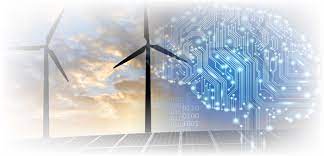Renewable energy, heralded as the future of sustainable power generation, is experiencing a profound transformation through the integration of artificial intelligence (AI). This marriage of cutting-edge technology and environmental stewardship holds immense promise for revolutionizing the way we produce, distribute, and consume energy.
1. Introduction to AI and Renewable Energy
AI, with its ability to analyze vast amounts of data and derive actionable insights, is reshaping the renewable energy landscape. By leveraging machine learning algorithms and predictive analytics, renewable energy systems can be optimized for efficiency and reliability.
2. Applications of AI in Renewable Energy
H1: Optimization of Energy Systems
AI plays a pivotal role in optimizing energy systems by fine-tuning parameters such as generation output, storage capacity, and transmission efficiency. Through continuous analysis of real-time data, AI algorithms can dynamically adjust energy production to match demand fluctuations, maximizing utilization and minimizing waste.
H2: Predictive Maintenance
Predictive maintenance powered by AI enables proactive identification of equipment failures and performance degradation in renewable energy infrastructure. By monitoring various operational parameters and detecting anomalies, AI algorithms can schedule maintenance activities preemptively, reducing downtime and operational costs.
H3: Weather Forecasting and Energy Production
AI-driven weather forecasting models enhance the accuracy of renewable energy production forecasts. By integrating meteorological data with historical energy generation patterns, AI algorithms can predict future output with remarkable precision, enabling grid operators to optimize resource allocation and mitigate the impact of weather variability.
3. Challenges and Solutions
H1: Data Quality and Quantity
One of the primary challenges in leveraging AI for renewable energy is the availability and quality of data. Ensuring access to comprehensive datasets encompassing diverse geographical regions and energy sources is crucial for training robust AI models capable of delivering accurate predictions and insights.
H2: Interdisciplinary Collaboration
Addressing complex challenges at the intersection of AI and renewable energy requires interdisciplinary collaboration between experts in data science, engineering, environmental science, and policy. By fostering partnerships across diverse domains, innovative solutions can be developed to accelerate the adoption of AI-driven renewable energy technologies.
H3: Regulatory Frameworks
Adapting regulatory frameworks to accommodate the rapid advancements in AI and renewable energy is essential for fostering innovation while safeguarding consumer interests and environmental sustainability. Establishing transparent guidelines for data sharing, privacy protection, and algorithmic transparency is paramount to ensure ethical and responsible deployment of AI in the renewable energy sector.
4. Advantages of AI in Renewable Energy
H1: Increased Efficiency
AI-driven optimization techniques enhance the efficiency of renewable energy systems by maximizing energy output, minimizing resource consumption, and reducing operational costs. Through intelligent automation and adaptive control strategies, AI enables real-time optimization of energy production and distribution networks, resulting in enhanced overall system efficiency.
H2: Cost Reduction
By optimizing resource allocation, streamlining maintenance operations, and improving forecasting accuracy, AI technologies contribute to significant cost reductions across the renewable energy value chain. Lowering the levelized cost of energy (LCOE) makes renewable energy more economically competitive with traditional fossil fuel-based power generation, accelerating the transition to a sustainable energy future.
H3: Environmental Impact
AI-powered renewable energy solutions facilitate the transition to a low-carbon economy by reducing greenhouse gas emissions, minimizing environmental footprint, and promoting ecosystem conservation. By optimizing energy utilization and promoting energy efficiency, AI contributes to mitigating climate change and preserving biodiversity, ensuring a cleaner and healthier planet for future generations.
5. Case Studies
H1: Solar Energy
AI algorithms are revolutionizing the solar energy sector by improving solar panel efficiency, optimizing tilt angles, and predicting solar irradiance levels with high accuracy. By harnessing the power of AI-driven solar tracking systems and predictive analytics, solar power plants can maximize energy yield and enhance grid stability, paving the way for widespread solar adoption.
H2: Wind Power
In the wind power industry, AI technologies are utilized for turbine optimization, blade monitoring, and wind farm management. By analyzing wind speed patterns, turbine performance data, and structural health indicators, AI algorithms enable proactive maintenance, optimize power output, and extend the lifespan of wind turbines, driving down operational costs and enhancing energy reliability.
H3: Hydroelectric Power
AI-powered predictive maintenance and operational optimization solutions are transforming the hydroelectric power sector by maximizing turbine efficiency, minimizing downtime, and optimizing reservoir management. By integrating data from sensors, weather forecasts, and historical performance records, AI algorithms enable hydroelectric plants to operate more efficiently and sustainably, harnessing the power of flowing water to generate clean, renewable energy.
6. Future Trends
H1: Enhanced Grid Management
AI-driven grid management systems enable real-time monitoring, predictive maintenance, and dynamic load balancing, enhancing grid stability and resilience. By integrating renewable energy sources, energy storage systems, and demand-side management strategies, AI facilitates the transition to a decentralized, resilient energy infrastructure capable of accommodating fluctuating supply and demand patterns.
H2: Energy Storage Optimization
AI algorithms optimize energy storage systems by predicting demand patterns, managing charge-discharge cycles, and maximizing battery performance. By leveraging advanced analytics and machine learning techniques, AI enables efficient utilization of energy storage resources, ensuring reliable supply, and grid stability in renewable energy-integrated power systems.
H3: Integration with Smart Cities
AI-powered renewable energy solutions are integral to the development of smart cities, where energy production, distribution, and consumption are optimized for sustainability, efficiency, and resilience. By leveraging IoT sensors, predictive analytics, and intelligent control systems, smart cities can achieve energy autonomy, reduce carbon emissions, and enhance quality of life for residents.
7. Conclusion
The intersection of AI and renewable energy represents a paradigm shift in the global energy landscape, offering unparalleled opportunities for sustainable development, economic growth, and environmental preservation. By harnessing the transformative potential of AI-driven technologies, we can accelerate the transition to a clean energy future and mitigate the adverse impacts of climate change, ensuring a brighter, more sustainable tomorrow for generations to come.
FAQs (Frequently Asked Questions)
How does AI improve renewable energy efficiency?
- AI optimizes renewable energy systems by analyzing data, predicting output, and dynamically adjusting operations to maximize efficiency and minimize waste.
What role does AI play in predictive maintenance for renewable energy infrastructure?
- AI enables proactive identification of equipment failures and performance degradation through continuous monitoring, reducing downtime and operational costs.
How can interdisciplinary collaboration accelerate innovation in AI and renewable energy?
- Collaborating across diverse domains fosters innovation by combining expertise in data science, engineering, environmental science, and policy to address complex challenges effectively.
What are the key challenges in integrating AI with renewable energy?
- Challenges include data quality, interdisciplinary collaboration, and regulatory frameworks that need to be addressed to maximize the benefits of AI in the renewable energy sector.
What are some future trends in the intersection of AI and renewable energy?
- Future trends include enhanced grid management, energy storage optimization, and integration with smart cities, paving the way for a sustainable energy future.

